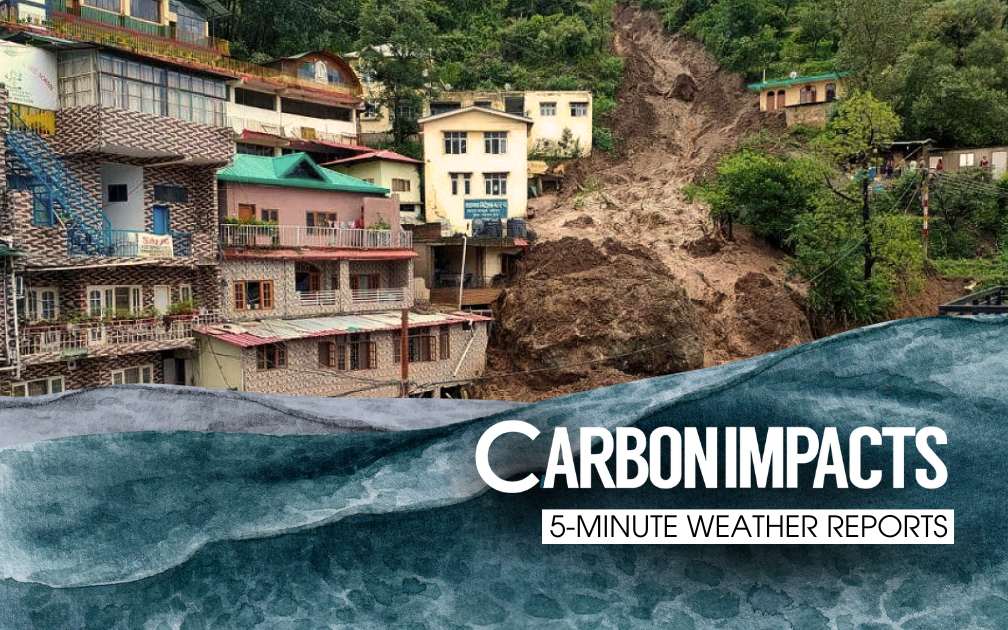Rainfall to Ruin: The Himalayan Monsoons in a Changing Climate | Episode 5
Flash floods, landslides, and the undeniable impact of climate change across Uttarakhand and Himachal: In this episode, we uncover the story behind the devastation and its profound implications.
By Carbon Impacts / Aug 19, 2023

Uttarakhand and Himachal Pradesh have been in shambles ever since the beginning of the Monsoon season.
What's behind the recent chaos in the Indian Himalayas due to the Monsoon season?
Uttarakhand and Himachal Pradesh have been in shambles ever since the beginning of the Monsoon season. The flash flooding coupled with landslides has caused millions of rupees worth of damage and killed several people in the hilly terrain.
Several rivers are in spate and have been running above the danger mark. The gushing water is sweeping away bridges, homes, and cars, causing widespread devastation, pushing states’ economy almost a decade behind.
What is causing these Monsoon impacts?
You see, the Monsoon trough, which guides the rainy season, shifted northward, leading to favourable weather conditions for heavy rainfall over the Himalayas. But here's the twist - climate change is in the mix too. It's like adding fuel to the fire, making these rainfall events even more intense.
How exactly does climate change connect with this Monsoon chaos?
With our planet heating up, the atmosphere, land, and oceans are warming too. And as they warm, they can hold more moisture. Think of it as the atmosphere turning into a sponge, ready to squeeze out heavy rainfall when it meets the right conditions.
This will be better explained by Dr Akshay Deoras, Meteorologist and Research Scientist, National Centre for Atmospheric Science and Department of Meteorology, University of Reading, United Kingdom.
Let’s take a moment to hear it in his words:
During break-Monsoon conditions, most monsoon rainfall activities get focussed over Himalayan foothills and to an extent over Himachal Pradesh and Uttarakhand. At the same time, other parts of the country, like Central India, witness dry weather conditions. This is not new and has been happening ever since the existence of Monsoon. The science of global warming is clear that if we continue to emit more and more greenhouse gases into the atmosphere, especially CO2, it will enhance the air’s capacity to hold more and more water. Now, whenever favourable weather conditions appear, for example, in the case of break monsoon conditions, the air will release much more water vapour in the form of rainfall. This means the probability of an ordinary rainfall event intensifying into a heavy or extremely heavy one will increase because of global warming,
Let's talk about humidity and temperature. How do they fit into this story?
We usually link climate change with increasing temperatures and often forget about humidity. Whereas humidity is the prime factor behind the increasing likelihood of heavier rainfall and even more dangerous heat waves. They both work in tandem. As temperatures soar, the air's capacity to hold moisture expands. According to experts, this heightened humidity and rising temperatures form the twin pillars of climate change.
Shifting our focus back to the Himalayas, what's happening amidst these changes?
What happened just last week was primarily because of the weather conditions, but what happened in July was quite unusual. Climate change has been altering as well as weakening the Monsoon systems. In this case, we saw more active western disturbances interacting with Monsoon systems, which is not usual. And then warming conditions further worsened the case.
The Himalayas, often referred to as the region's "water towers," are undergoing profound changes due to climate change. Glacier melt and erratic snowfall patterns are all occurring at an alarming rate. The effects are undeniable, with significant consequences for ecosystems, biodiversity, and human well-being.
As these extreme weather events become more frequent, it’s clear that urgent climate action is needed to protect our communities, and ensure a safer future for everyone.
MonsoonUttarakhandHimachal PradeshFloodsLandslides

